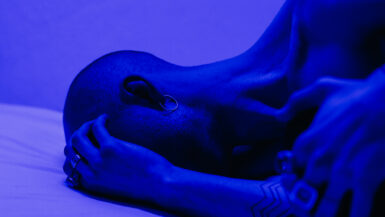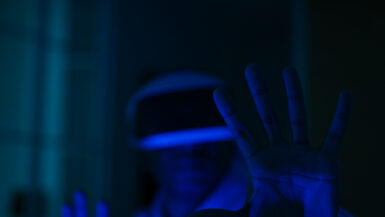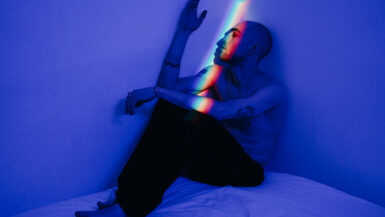In today’s fast-paced and technology-driven world, the impact of artificial blue light exposure on our sleep quality and overall productivity has become a topic of increasing concern. In this article, we delve into the complex relationship between blue light and sleep quality, exploring the science behind blue light’s effect on our circadian rhythm, the potential consequences of prolonged exposure, and the practical steps that can be taken to mitigate these adverse effects. By understanding the connection between blue light and sleep, we aim to empower our readers with the knowledge to make informed choices about their screen time habits, ultimately contributing to healthier sleep patterns and enhanced productivity in their daily lives.
The Impact of Blue Light Exposure on Sleep Quality
As our lives become increasingly intertwined with technology, it’s essential to understand how blue light exposure from screens can affect our sleep quality. In this section, we will discuss the science behind blue light’s impact on sleep, the potential consequences of prolonged exposure, and steps to mitigate these effects. By recognizing the connection between blue light and sleep quality, we can make informed choices to support healthier sleep patterns and better overall well-being.
Blue Light’s Effect on Circadian Rhythm
The circadian rhythm is our body’s internal clock that regulates our sleep-wake cycle, and it is highly sensitive to light exposure. Blue light, which is emitted by screens such as smartphones, tablets, and computers, can interfere with the production of melatonin, a hormone that helps regulate sleep. According to Blue Light and Sleep: A Comprehensive Guide for Healthcare Professionals, exposure to blue light in the evening can disrupt our circadian rhythm, making it more difficult to fall asleep and resulting in poorer sleep quality.
Consequences of Prolonged Blue Light Exposure on Sleep
Consistent exposure to blue light before bedtime can lead to a variety of sleep-related issues. These may include difficulty falling asleep, frequent awakenings during the night, and reduced overall sleep duration. Over time, these sleep disturbances can contribute to mood disorders, decreased cognitive function, and weakened immune system. Moreover, poor sleep quality has been linked to an increased risk of chronic health conditions such as obesity, diabetes, and cardiovascular disease.
Practical Steps to Minimize Blue Light Exposure
To reduce the impact of blue light on sleep quality, it is vital to implement practical strategies that limit our exposure, especially in the hours leading up to bedtime. These steps may include wearing blue light blocking glasses, using screen filters or apps that adjust the color temperature of displays, and establishing a screen-free bedtime routine. Additionally, creating a sleep-friendly environment by reducing ambient light sources and maintaining a consistent sleep schedule can further support healthy sleep patterns.
In summary, understanding the connection between blue light and sleep quality is crucial for navigating our technology-driven world. By taking proactive measures to limit blue light exposure and prioritize healthy sleep habits, we can enjoy better sleep quality and increased productivity in our daily lives.
Tips for Reducing Blue Light Exposure Before Bedtime
As we have established the connection between blue light and sleep quality, it becomes crucial to effectively manage our exposure to blue light, particularly in the evening hours. In this section, we provide practical tips and strategies for reducing blue light exposure before bedtime, helping you establish a healthier sleep routine and ultimately promoting better overall well-being.
Create a Screen-Free Bedtime Routine
Establishing a bedtime routine that does not involve screens is an effective way to minimize blue light exposure in the evening. Consider replacing your screen time with activities that promote relaxation, such as reading a physical book, practicing meditation, or engaging in light stretching. By cultivating a screen-free routine, you can signal to your body that it is time to wind down and prepare for sleep.
Wear Blue Light Blocking Glasses
Investing in a pair of blue light blocking glasses can be a helpful tool in reducing the impact of blue light on your sleep. These glasses are designed to filter out the blue light emitted from screens, helping to protect your eyes and support your circadian rhythm. Wearing these glasses in the evening can help mitigate the effects of blue light on your sleep quality.
Utilize Screen Filters and Apps
Several screen filters and apps are available to minimize blue light exposure from electronic devices. These filters and apps adjust the color temperature of your screen, reducing the amount of blue light emitted. Many devices have a built-in “night mode” or “blue light filter” setting that can be enabled in the evening hours to promote a healthier sleep environment.
Manage Your Screen Time
Being mindful of your overall screen time, especially in the hours leading up to bedtime, is essential in managing blue light exposure. Set limits on your screen time and consider setting a “technology curfew” an hour or two before sleep. This can help decrease blue light exposure and give your body time to wind down before bed.
Optimize Your Sleep Environment
In addition to managing blue light exposure from screens, it is essential to create a sleep-friendly environment that promotes relaxation and restful sleep. Reduce ambient light sources in your bedroom, use blackout curtains or an eye mask, and maintain a comfortable temperature. These factors can help reinforce your body’s natural sleep-wake cycle and support better sleep quality.
By implementing these practical tips for reducing blue light exposure before bedtime, you can take control of your sleep health and experience the benefits of improved sleep quality and enhanced productivity in your daily life.
Blue Light Exposure and Its Effects on Productivity
In this section, we explore the intricate relationship between blue light exposure and productivity levels. By examining the underlying mechanisms, we can better understand how blue light affects our cognitive function, work performance, and overall well-being. This knowledge can then be applied to develop strategies to optimize our exposure to blue light, ultimately improving productivity and enhancing our daily lives.
The Science Behind Blue Light and Cognitive Function
Blue light exposure not only affects our sleep quality but also has a direct impact on our cognitive function. According to a study published in Sleep Science, blue light can stimulate alertness and improve attention, memory, and reaction time. This is due to its ability to suppress melatonin production, which in turn activates the arousal-promoting neurotransmitter, orexin. While this increased alertness can be beneficial during daytime hours, excessive blue light exposure during the evening hours can disrupt our natural sleep-wake cycle and ultimately hinder cognitive function.
The Consequences of Disrupted Sleep on Work Performance
Poor sleep quality resulting from excessive blue light exposure can have a significant impact on work performance. A study published in the journal SLEEP found that sleep-deprived individuals experienced reduced attention, decision-making abilities, and problem-solving skills. Moreover, chronic sleep deprivation can lead to increased errors, accidents, and reduced overall productivity. Thus, it is essential to manage blue light exposure to maintain optimal cognitive function and work performance.
Strategies for Balancing Blue Light Exposure and Productivity
To achieve a balance between blue light exposure and productivity, it is crucial to implement strategies that maximize the benefits of blue light during daytime hours while minimizing its negative effects in the evening. These strategies may include:
1. Taking advantage of natural daylight: Exposing yourself to natural sunlight during the day can help regulate your circadian rhythm, improve alertness, and boost productivity.
2. Adjusting screen brightness: Ensure your screen’s brightness is appropriate for the ambient light conditions, reducing eye strain and fatigue.
3. Scheduling screen breaks: Regularly taking short breaks from screens throughout the day can help maintain focus and prevent eye strain.
4. Limiting evening screen time: Manage your screen time in the evening hours to reduce blue light exposure, allowing your body to wind down and prepare for sleep.
5. Creating a conducive work environment: Optimize your workspace by reducing glare, positioning your screen at a comfortable distance, and maintaining proper posture to support productivity and focus.
By understanding the relationship between blue light exposure and productivity, we can take effective steps to optimize our screen time and create a healthy balance that supports cognitive function, work performance, and overall well-being.
How Blue Light Affects Our Circadian Rhythm
In this subsection, we will delve deeper into the mechanisms through which blue light exposure influences our circadian rhythm, the body’s internal clock responsible for regulating our sleep-wake cycle. By gaining a thorough understanding of this connection, we can better appreciate the importance of managing our exposure to blue light in order to maintain healthy sleep patterns and overall well-being.
The Role of Blue Light in Regulating Our Internal Clock
Our circadian rhythm is primarily governed by the hypothalamus, a region in our brain that responds to various environmental cues such as light and darkness. Blue light, which has a wavelength of around 480 nanometers, is particularly effective in stimulating photoreceptor cells called intrinsically photosensitive retinal ganglion cells (ipRGCs) found in our eyes. These cells then transmit information about light exposure to the suprachiasmatic nucleus (SCN), a cluster of neurons in the hypothalamus responsible for controlling our internal clock.
Melatonin Suppression and Sleep Onset
One of the primary ways in which blue light affects our circadian rhythm is through its impact on melatonin production. Melatonin, often referred to as the “sleep hormone,” plays a crucial role in regulating our sleep-wake cycle by promoting drowsiness and facilitating the onset of sleep. When we are exposed to blue light, especially in the evening hours, melatonin production is suppressed, leading to increased alertness and a delayed onset of sleep.
Disruption of Sleep Quality and Duration
Excessive exposure to blue light, especially before bedtime, can have a detrimental impact on the quality and duration of our sleep. As blue light suppresses melatonin production and delays sleep onset, it can result in a shorter overall sleep duration and increased awakenings during the night. Furthermore, this disruption in sleep patterns can lead to a misalignment of our internal clock, resulting in feelings of grogginess, fatigue, and reduced cognitive function during daytime hours.
Chronotype Alterations and Social Jetlag
Chronotype refers to an individual’s innate preference for morning or evening activity, which is influenced by their unique circadian rhythm. Excessive blue light exposure can shift an individual’s chronotype, making them more prone to staying up late and experiencing difficulty waking up in the morning. This misalignment between one’s internal clock and societal demands, such as work or school schedules, can result in a phenomenon known as social jetlag. Social jetlag is associated with various negative health outcomes, including sleep disturbances, mood disorders, and a heightened risk of chronic conditions like obesity and diabetes.
To sum up, understanding the impact of blue light on our circadian rhythm is crucial for maintaining healthy sleep patterns and overall well-being. By being mindful of our exposure to blue light, especially in the evening hours, we can support our body’s natural sleep-wake cycle, leading to improved sleep quality and enhanced cognitive function during the day.
Understanding Blue Light and Its Sources
As we explore the connection between blue light and sleep quality, it is essential to understand what blue light is and where it comes from. In this subsection, we will delve into the science behind blue light, its natural and artificial sources, and the role it plays in our daily lives. By comprehending the origin and characteristics of blue light, we can better appreciate its impact on our sleep patterns and devise effective strategies to manage our exposure.
The Science Behind Blue Light
Blue light is a part of the visible light spectrum, comprising a range of wavelengths from approximately 380 to 500 nanometers. It is characterized by its short wavelength and high energy, which distinguishes it from other colors in the spectrum. Blue light is known to have both beneficial and adverse effects on our health and well-being, depending on the timing, intensity, and duration of exposure.
Natural Sources of Blue Light: The Sun
The most significant and natural source of blue light is the sun. Exposure to sunlight during daytime hours provides us with essential blue light that helps regulate our circadian rhythm, boost mood, and enhance cognitive function. In this context, blue light plays a vital role in maintaining our overall health and well-being. However, it is crucial to balance our exposure to sunlight with proper eye protection, as excessive exposure can contribute to eye strain and potential long-term damage.
Artificial Sources of Blue Light: Electronic Devices and LED Lighting
In addition to sunlight, blue light is emitted by various artificial sources, including electronic devices such as smartphones, tablets, computers, and televisions. LED lighting, which is increasingly common in homes and workplaces, also emits blue light. While these artificial sources tend to emit lower levels of blue light compared to the sun, our proximity and extended exposure to these devices can still have a significant impact on our sleep quality and overall health.
Managing Blue Light Exposure for Optimal Sleep and Health
To maintain healthy sleep patterns and minimize the adverse effects of blue light exposure, it is essential to strike a balance between benefiting from its natural sources and managing our exposure to artificial sources. This can be achieved by embracing strategies such as spending time outdoors during daylight hours, limiting screen time in the evening, and utilizing blue light filtering technologies. By understanding the sources of blue light and adopting a mindful approach to our exposure, we can support our body’s natural sleep-wake cycle, leading to improved sleep quality and overall well-being.





Leave a reply